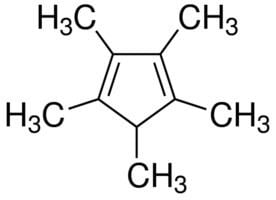Formula C10H16 | Molar mass 136.24 g/mol | |
 | ||
What does pentamethylcyclopentadiene mean
1,2,3,4,5-Pentamethylcyclopentadiene is a cyclic dialkene with the formula C5Me5H (Me = CH3). 1,2,3,4,5-Pentamethylcyclopentadiene is the precursor to the ligand 1,2,3,4,5-pentamethylcyclopentadienyl, which is often denoted Cp* (to signify the five methyl groups radiating from the periphery of this ligand as in a five-pointed star). In contrast to less-substituted cyclopentadiene derivatives, Cp*H is not prone to dimerization.
Contents
- What does pentamethylcyclopentadiene mean
- Synthesis
- Organometallic derivatives
- Comparison of Cp with Cp
- References
Synthesis
Pentamethylcyclopentadiene is commercially available. It was first prepared from tiglaldehyde via 2,3,4,5-tetramethylcyclopent-2-enone. Alternatively 2-butenyllithium adds to ethyl acetate followed by acid-catalyzed dehydrocyclization:
2 MeCH=C(Li)Me + MeC(O)OEt → (MeCH=C(Me))2C(OLi)Me + LiOEt(MeCH=C(Me))2C(OLi)Me + H+ → Cp*H + H2O + Li+Organometallic derivatives
Cp*H is a precursor to organometallic compounds containing the C
5Me−
5 (Cp*−) ligand.
Some representative reactions leading to such Cp*–metal complexes follow:
Cp*H + C4H9Li → Cp*Li + C4H10Cp*Li + TiCl4 → Cp*TiCl3 + LiCl2 Cp*H + 2 Fe(CO)5 → [Cp*Fe(CO)2]2 + H2 + COFor the related Cp complex, see cyclopentadienyliron dicarbonyl dimer.
An instructive but obsolete route to Cp* complexes involves the use of hexamethyl Dewar benzene. This method was traditionally used for preparation of the chloro-bridged dimers [Cp*IrCl2]2 and [Cp*RhCl2]2. Such syntheses rely on a hydrohalic acid induced rearrangement of hexamethyl Dewar benzene to a substituted pentamethylcyclopentadiene prior to reaction with the hydrate of either iridium(III) chloride or rhodium(III) chloride.
Comparison of Cp* with Cp
Complexes of pentamethylcyclopentadienyl differ in several ways from the more common cyclopentadienyl (Cp) derivatives. Being more electron-rich, Cp* is a stronger donor and is less easily displaced from the metal. Its steric bulk stabilizes complexes with fragile ligands. Its bulk also attenuates intermolecular interactions, decreasing the tendency to form polymeric structures. Its complexes also tend to be more soluble in non-polar solvents. The methyl group in Cp* complexes can undergo C–H activation leading to "tuck-in complexes".
